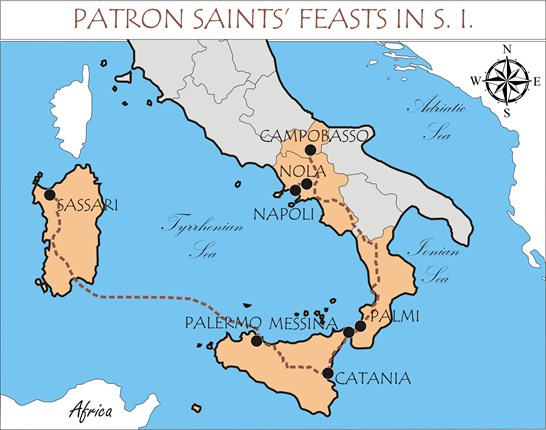Patronal Feasts in Southern Italy
 Any Italian town has at least one Feast of a patron saint, to which other important religious observations are added. On such occasions, statues, statuary groups or scenic apparatuses (“machines”) are carried in procession in the streets of Italian cities to stage episodes inspired by the Holy Scriptures, the lives of the saints and the most famous mysteries of the Christian religion. In most cases they consist in wonderful processional pageants of enormous size, variously referred to as Vare (as happens in the Feast of the Assumption of Messina and Santa Rosalia in Palermo), Ceri (this is the case of the Cannelore of Sant’Agata, of the Gigli of Nola and Candelieri of Sassari), Carri (such as that of Sant’Efisio in Cagliari) or the Misteri (in the case of those who march in the Corpus Domini of Campobasso). The terms vara and misteri are also used to indicate the statuary groups that still see parading during Holy Week. A particular type of Feast of patron saints or religious celebrations in which the Vare of the saints parade are the so-called celebrations of Moors and Christians.
Any Italian town has at least one Feast of a patron saint, to which other important religious observations are added. On such occasions, statues, statuary groups or scenic apparatuses (“machines”) are carried in procession in the streets of Italian cities to stage episodes inspired by the Holy Scriptures, the lives of the saints and the most famous mysteries of the Christian religion. In most cases they consist in wonderful processional pageants of enormous size, variously referred to as Vare (as happens in the Feast of the Assumption of Messina and Santa Rosalia in Palermo), Ceri (this is the case of the Cannelore of Sant’Agata, of the Gigli of Nola and Candelieri of Sassari), Carri (such as that of Sant’Efisio in Cagliari) or the Misteri (in the case of those who march in the Corpus Domini of Campobasso). The terms vara and misteri are also used to indicate the statuary groups that still see parading during Holy Week. A particular type of Feast of patron saints or religious celebrations in which the Vare of the saints parade are the so-called celebrations of Moors and Christians.
Sometimes the Feasts of patronal saints nowadays, despite being just as rich in symbolic elements retain only some of the scenic apparatuses in vogue during the Baroque period (this is the case of the ceremonies in honour of San Gennaro). These scenic apparatuses, however, can still be found in the festivities in which the processional and parading Giants play a major role. To participate now in the most important Feasts in southern Italy is an engrossing experience, as it allows you to relive the atmosphere which is only seemingly obsolete, in which each object, gesture and ritual has a strong symbolic connotation. The persistence or the reinvention of Italian Baroque elements in the Feasts in fact has something in common with our time: an age dominated by visual culture and new and an increasingly complex symbolic apparatuses and pervaded by a sensibility that, not surprisingly, has been called neo-Baroque.
